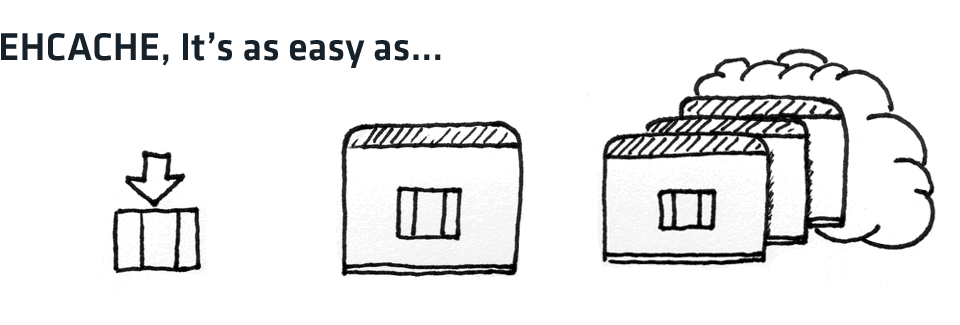进程内缓存框架EhCache
进程内缓存框架 EhCache- Author: Poechant
- Blog:?blog.CSDN.net/Poechant
- Email: zhongchao.ustc#gmail.com (#->@)
- Date: February 27th, 2012
1. What the hell is EhCache?

EhCache?是一个纯Java的进程内缓存框架,具有快速、精干等特点,是Hibernate中默认的CacheProvider。EhCache 具有以下特点(摘自开源中国社区)。
- 快速
- 简单
- 多种缓存策略
- 缓存数据有两级:内存和磁盘,因此无需担心容量问题
- 缓存数据会在虚拟机重启的过程中写入磁盘
- 可以通过 RMI、可插入 API 等方式进行分布式缓存
- 具有缓存和缓存管理器的侦听接口
- 支持多缓存管理器实例,以及一个实例的多个缓存区域
- 提供 Hibernate 的缓存实现
2. 常用 API构造函数方法原型public Cache(String name, int maxElementsInMemory, boolean overflowToDisk, boolean eternal, long timeToLiveSeconds, long timeToIdleSeconds)
该构造函数是?EhCache 1.0 版本中的出现的,后续开发到 2.0 之后,出现了带有 CacheConfiguration 参数的构造函数,用法更强大。比如如下这个:
public Cache(CacheConfiguration cacheConfiguration, RegisteredEventListeners registeredEventListeners, BootstrapCacheLoader bootstrapCacheLoader)
用法可参见?EhCache 的 API Docs。
参数含义name - 缓存的名称,default`保留为默认缓存名称;maxElementsInMemory?- 内存中的最大同时缓存元素个数;overflowToDisk?- 是否持久化(使用磁盘);eternal?- 对象是否永久有效(永不过期);timeToLiveSeconds?- 对象从其创建开始计算的生存时间(秒);timeToIdleSeconds?- 对象从其最后一次被访问开始计算的生存时间(秒)。一般来说,只有?name、maxElementsInMemory?和?timeToLiveSeconds?显式设置,其他的参数常根据其不同的类型而设置为?false、0?等。
put 方法方法原型public final void put(Element element) throws IllegalArgumentException, IllegalStateException, CacheException
参数含义- element:所要存储的元素,可参见其定义?Element?API Docs。它是 EhCache 中缓存的基本单元。
get 方法方法原型public final Element get(Object key) throws IllegalStateException, CacheException
参数含义- key:可以为任意类型的 key,比较灵活。
remove 方法方法原型public final boolean remove(Object key) throws IllegalStateException
参数含义- key:指定的 key。
3. 示例源码package com.sinosuperman.ehcache;import net.sf.ehcache.Cache;import net.sf.ehcache.Element;public class Test { public static void main(String[] args) { String name = "Namespace"; int capacity = 500; int refreshPeriod = 5000; // Initialize EhCache Cache cache = new Cache(name, capacity, false, false, refreshPeriod, 0); cache.initialise(); System.out.println( "Initialize EhCache: " + " name: " + name + " capacity: " + capacity + " expire: " + refreshPeriod ); // Set data into EhCache String key1 = "Key"; String value1 = "Value"; Element element1 = new Element(key1, value1); cache.put(element1); System.out.println("Set (" + key1 + ", " + value1 + ") into EhCache."); // Get data from EhCache Element element2 = cache.get(key1); String key2 = (String) element2.getObjectKey(); String value2 = (String) element2.getObjectValue(); System.out.println("Get (" + key2 + ", " + value2 + ") from EhCache."); // Remove data from EhCache if (cache.remove(key2)) { System.out.println("Remove data with key = " + key2 + " successfully."); } // Get EhCache size System.out.println("EhCache size is " + cache.getSize()); }}
结果SLF4J: Failed to load class "org.slf4j.impl.StaticLoggerBinder".SLF4J: Defaulting to no-operation (NOP) logger implementationSLF4J: See http://www.slf4j.org/codes.html#StaticLoggerBinder for further details.Initialize EhCache: name: Namespace capacity: 500 expire: 5000Set (Key, Value) into EhCache.Get (Key, Value) from EhCache.Remove data with key = Key successfully.EhCache size is 0
进一步了解
可以登陆?EhCache.org,他们的文档还蛮多的。Enjoy EhCache!
-
转载请注明来自“柳大的CSDN博客”:?blog.CSDN.net/Poechant
-
1. What the hell is EhCache?

EhCache?是一个纯Java的进程内缓存框架,具有快速、精干等特点,是Hibernate中默认的CacheProvider。EhCache 具有以下特点(摘自开源中国社区)。
- 快速
- 简单
- 多种缓存策略
- 缓存数据有两级:内存和磁盘,因此无需担心容量问题
- 缓存数据会在虚拟机重启的过程中写入磁盘
- 可以通过 RMI、可插入 API 等方式进行分布式缓存
- 具有缓存和缓存管理器的侦听接口
- 支持多缓存管理器实例,以及一个实例的多个缓存区域
- 提供 Hibernate 的缓存实现
2. 常用 API
构造函数
方法原型
public Cache(String name, int maxElementsInMemory, boolean overflowToDisk, boolean eternal, long timeToLiveSeconds, long timeToIdleSeconds)该构造函数是?EhCache 1.0 版本中的出现的,后续开发到 2.0 之后,出现了带有 CacheConfiguration 参数的构造函数,用法更强大。比如如下这个:
public Cache(CacheConfiguration cacheConfiguration, RegisteredEventListeners registeredEventListeners, BootstrapCacheLoader bootstrapCacheLoader)用法可参见?EhCache 的 API Docs。
参数含义
name - 缓存的名称,default`保留为默认缓存名称;maxElementsInMemory?- 内存中的最大同时缓存元素个数;overflowToDisk?- 是否持久化(使用磁盘);eternal?- 对象是否永久有效(永不过期);timeToLiveSeconds?- 对象从其创建开始计算的生存时间(秒);timeToIdleSeconds?- 对象从其最后一次被访问开始计算的生存时间(秒)。一般来说,只有?
name、maxElementsInMemory?和?timeToLiveSeconds?显式设置,其他的参数常根据其不同的类型而设置为?false、0?等。put 方法
方法原型
public final void put(Element element) throws IllegalArgumentException, IllegalStateException, CacheException参数含义
- element:所要存储的元素,可参见其定义?Element?API Docs。它是 EhCache 中缓存的基本单元。
get 方法
方法原型
public final Element get(Object key) throws IllegalStateException, CacheException参数含义
- key:可以为任意类型的 key,比较灵活。
remove 方法
方法原型
public final boolean remove(Object key) throws IllegalStateException参数含义
- key:指定的 key。
3. 示例
源码
package com.sinosuperman.ehcache;import net.sf.ehcache.Cache;import net.sf.ehcache.Element;public class Test { public static void main(String[] args) { String name = "Namespace"; int capacity = 500; int refreshPeriod = 5000; // Initialize EhCache Cache cache = new Cache(name, capacity, false, false, refreshPeriod, 0); cache.initialise(); System.out.println( "Initialize EhCache: " + " name: " + name + " capacity: " + capacity + " expire: " + refreshPeriod ); // Set data into EhCache String key1 = "Key"; String value1 = "Value"; Element element1 = new Element(key1, value1); cache.put(element1); System.out.println("Set (" + key1 + ", " + value1 + ") into EhCache."); // Get data from EhCache Element element2 = cache.get(key1); String key2 = (String) element2.getObjectKey(); String value2 = (String) element2.getObjectValue(); System.out.println("Get (" + key2 + ", " + value2 + ") from EhCache."); // Remove data from EhCache if (cache.remove(key2)) { System.out.println("Remove data with key = " + key2 + " successfully."); } // Get EhCache size System.out.println("EhCache size is " + cache.getSize()); }}结果
SLF4J: Failed to load class "org.slf4j.impl.StaticLoggerBinder".SLF4J: Defaulting to no-operation (NOP) logger implementationSLF4J: See http://www.slf4j.org/codes.html#StaticLoggerBinder for further details.Initialize EhCache: name: Namespace capacity: 500 expire: 5000Set (Key, Value) into EhCache.Get (Key, Value) from EhCache.Remove data with key = Key successfully.EhCache size is 0进一步了解
可以登陆?EhCache.org,他们的文档还蛮多的。Enjoy EhCache!
-
转载请注明来自“柳大的CSDN博客”:?blog.CSDN.net/Poechant
-
- key:指定的 key。
- key:可以为任意类型的 key,比较灵活。
- element:所要存储的元素,可参见其定义?Element?API Docs。它是 EhCache 中缓存的基本单元。